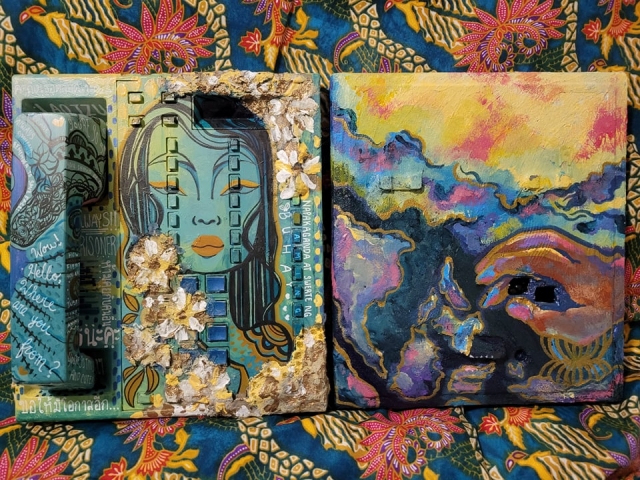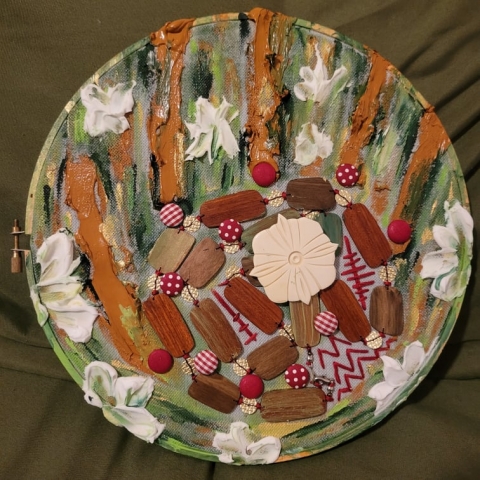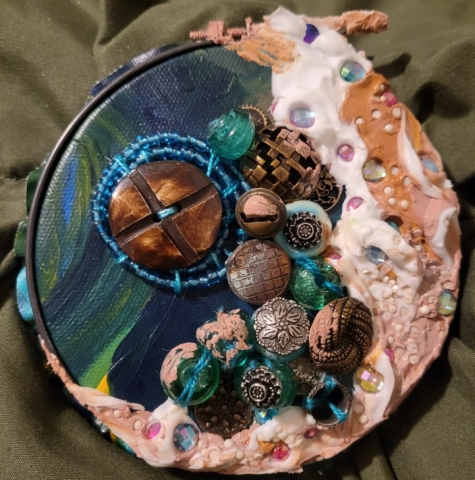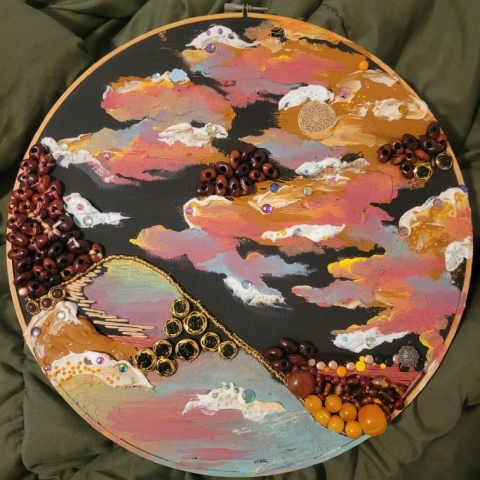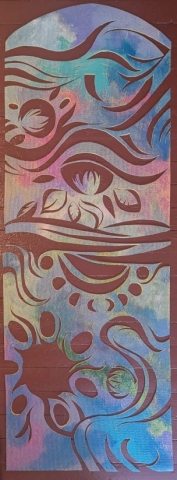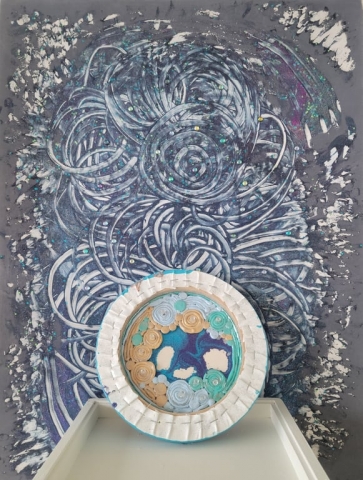Ashley Abigail Gruezo Resurreccion
Artwork Title: Re-savoir: Kapag ang dagat ay tahimik, asahan mo at malalim
Year: 2021
Medium: Clay and Acrylics on Canvas; Glitter on Sandpaper
Artist Statement
Your silhouette is balanced with paper cuts,
Black and white
Like the edges that surround you.
In these spaces, I see tears.
I see bold colors.
I see heavy burdens.
Histories blending in the background
Shape the foreground of your portrait.
The toxins of this practice seep into the marrow of my bones
Until the blood leaves my hands through this sand-papered surface
And the skeleton that remains is all that I had left to tie me to my ancestors –
Ancestors whose lives have been erased through endless cycles of suffering –
Suffering in which survival is equated to resilience –
Resilience which taught me existence required silence –
Silence, like the lifeless force of these borrowed spaces
Where fingerprints trace to die in the grains of our lands
And erase the identity of my (de)colonized life.
“I want the intersectionality of my soul to be unconditionally regarded, and for our unequal walls to be dismantled, so that we may live within a place of healing rather than dissonance.”
Click on artwork to read more about it.
ABOUT THE ARTIST
Ashley Abigail Gruezo Resurreccion (siya/they/them) is a Filipina Asian-American, certified 200-Hour Yoga Teacher, and Returned United States Peace Corps Volunteer (Thailand 130) who graduated from California State University, Northridge with a BA in Psychology and minors in Sociology, Child Development, and Art. Their previous work promoted mental wellness and educational sustainability with The International Child Advocacy Network, Self-Discovery Through Art, Art Expression Inc., and Project Art. In 2021, they served as a Multicultural Committee member and Intern with the American Art Therapy Association (AATA), Secretary with the Pennsylvania Association of Specialists in Group Work (PASGW), and Member with the Association of Filipino Scientists in America (AFSA).
Art therapy is their instrument for healing the weights of our cultural somatics and empowering the future leaders of our field. They use it in roles as a Resident Artist, art and yoga teacher, and freelance zinester to support Asian, Asian-American, and LGBTQIA2S+ populations. Studying to earn a Master of Arts in Art Therapy with a Specialization in Counseling at Seton Hill University, they hope to someday construct their own creative meditation center that honors culturally appropriate Asian and Asian-American inspired artmaking, spirituality, and mindful yoga practices.
- What drew you to the field of art therapy?
- What drives your current work?
- Where do you see the field going?
- What impact is needed to effect changes regarding DEI within the field of art therapy?
Having engaged in art therapy in various forms throughout my life, my approach to work is as multi-faceted as my identity. As a child, art (as) therapy allowed me to explore my multicultural identity of being a non-binary, Filipino/-American with a low socioeconomic status in the outskirts of Los Angeles, CA. Art therapy also became my instrument for communicating my global experiences with de/-colonization and “balikbayan” culture i.e., the synthesis of two Tagalog words coined by the Marcos regime in the 1970s: “balik” (to return, to go back) and “bayan” (homeland), which refers to any person returning to the Philippines of Filipino descent living abroad.
I did not have access to ‘formal’ art therapy as a client due to social and financial inaccessibility. That said, the fondest recollections of my childhood involve drawing all over my bedroom walls with crayons and markers my mother gifted me, writing poems to honor my ancestors, making cardboard castles and Sumi ink paintings with siblings and friends, and learning how to patiently create art through the impermanence of an Etch-a-Sketch. When I learned about art therapy as an authentic profession in high school, I recognized that I was already on its path and shifted all higher educational efforts towards it.
As a Resident Artist of ProjectART and as an Art Therapy graduate student, my current work inspires symbiotic relationships between the communities and organizations I participate in and collaborate with. Ecosystemic needs, diaspora-based experiences, and intergenerational histories, grows, and glows nourish the heart of my decolonization artwork and facilitate multicultural educational. Each artwork is like a family heirloom that carries reclaimed objects, used/recycled materials, and gifted art supplies that carry each object’s ancestral lineage and ties it with my own. In this way, the artmaking process expresses gratitude for the curiosities, challenges, and triumphs that the art and I have lived through – and the countless lives before us that has held them together as sacred. I hope that the connections we make through practice, research, and social justice advocacy can alleviate the challenges our communities face and promote sustainable changes.
Since the art therapy profession is fairly new, I hope to see more individuals of global majorities represented as professionals and students alike. Neocolonialism is a current ongoing process, and it is important to build our mindfulness of our present participation. I hope we can do better to record rather than erase; learn rather than exclude; and heal rather than stay ignorant, if we truly want to weave equity into our future and make art therapy more accessible for everyone.
When I think about true equity and DEI, I think about the word “Re-savoir”. Paronomasia for reservoir, it means to “Re-know” oneself and be the source that mirrors the transience of life explorations; however, it simultaneously plays on the connotations of a “savior“, especially within the context of de/-colonization. A heartfelt Filipino proverb also comes to mind: “Kapag ang dagat ay tahimik, asahan mo at malalim.” To me, this emphasizes that people who are calm have a lot of passion inside; and, inherently, hold a deeper reservoir with which to advocate for our community and embrace life. Competence, performative representation, and performative activism is not a realistic nor sustainable goal; rather, I perceive multiculturalism as a complex mirroring connection between different entities.
With this sentiment, it is crucial that we, as a profession, hold ourselves accountable for how we navigate our communities. Let us question our systemic structures both within and outside of AATA for the improvement of art therapy across the nation, make genuine changes that reflect proper policies for art therapy accessibility, examine programs to ensure they have non-tokenized diverse faculty and student populations, and remind ourselves that research and work are ideal when they mirror the people we are truly trying to empower.

